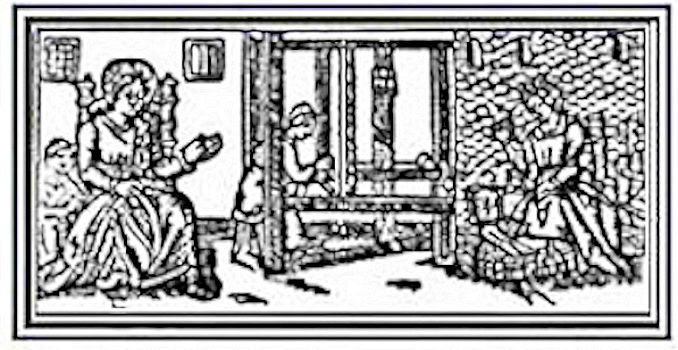The formula of crimp, twist and wheel ratios for spinning perfect yarns
This post has been updated – Please visit:
Crimp Twist Ply
How do you figure out how much twist to add to your yarn? One way, is to look at the fleece and spin with the crimp, rather than fighting against it. If your end product is to be a thick, low twist yarn, then start with a fleece that has a lower crimp count, such as a Romney or a Coopworth. If you wish to spin a fine, high twist yarn, then use a fleece that has these characteristics, such as a Merino or a Cheviot. A lot of times I spin without paying particular attention to the crimp or the twist, but just spin for the pleasure of spinning and what feels right at the moment. But when I look at the yarn afterwards, I find that I have been spinning with the crimp for the most part. The fleece does know how it wants to be spun, naturally. Here is a more technical explanation of what happens, as I understand it. Of course, I welcome additional comments from more experienced spinners than I. So please, post your suggestions, and experiences to our Facebook Page.
Spinning with the Crimp
Lay the locks of the fleece you have selected against a ruler and count the number of crimps or bumps in the fleece. To spin with the crimp, the finished yarn will have the same number of twists as the original fleece has in crimp count.
If the fleece has 5 crimps per inch, then your finished, plied yarn should also have 5 twists per inch. If the fleece has 12 crimps per inch, the finished yarn is best spun to 12 tpi as well.
Formula of Twist and Ply
There may be another name for this, but I will call this the Formula of Twist and Ply.
If you are starting with a Romney fleece that has 5 crimps per inch, and you wish to spin with the crimp, the plied yarn should turn out to be 5 tpi. How do you achieve this? To spin a 2 ply yarn, the singles spun yarn should be spun at 1.5 times what the finished yarn should be. When you ply the 2 singles yarns, in the opposite direction, 1/2 of the twist that you added into both of the singles, goes into the twist to create the balanced yarn. Use this table as a guide of how to spin your fleece. But of course, you can alter the amount of spin of your yarn, depending on its intended use. For example, if you are spinning for socks, you might want to add additional twist to the yarn for increased strength.
| Crimp Count per Inch |
Singles TPI |
PlyTPI | |
| Formula | A | A * 1.5 | A |
| Borderdale | 5 | 7.5 | 5 |
| Cheviot | 5 | 7.5 | 5 |
| Coopworth | 4 | 6 | 4 |
| Corriedale | 5 | 7.5 | 5 |
| Lincoln | 2 | 3 | 2 |
| Merino | 11 | 16.5 | 11 |
| Perendale | 5 | 7.5 | 5 |
| Polwarth | 8 | 12 | 8 |
| Romney | 4 | 6 | 4 |
| Border Leicester | 2.5 | 3.75 | 2.5 |
This table is an approximation of the crimp in different breeds of fleece.
There is some variation so please do try to figure out the correct crimp for your fleece.
More about Handspinning
Beginning to Spin
Semi-Worsted Spinning
How Your Spinning Wheel Spins
How to Spin a Cabled Yarn
Woolen and Worsted Spinning
How to Spin and Ply Plant Fibre
0:00 Spinning and plying a slippery fibre such as Seacell
0:30 Spin at a high twist and ply 2 singles together
1:00 Keep an eye on the V as you are spinning looking for extra twist
2:00 Release the tension and let the wheel take out some of the twist
2:30 Plying helps to correct mistakes and overplying
Handspinning Books
The Fleece and Fiber Sourcebook: More Than 200 Fibers, from Animal to Spun Yarn
The Whole Craft of Spinning: From the Raw Material to the Finished Yarn
The Practical Spinner’s Guide – Cotton, Flax, Hemp (Practical Spinner’s Guides)
Spin Flax & Cotton: Traditional Techniques with Norman Kennedy
The Alden Amos Big Book of Handspinning: Being A Compendium of Information, Advice, and Opinions On the Noble Art & Craft
The Knitter’s Book of Wool: The Ultimate Guide to Understanding, Using, and Loving this Most Fabulous Fiber
The Intentional Spinner
 LONGTHREAD MEDIA VIDEO
LONGTHREAD MEDIA VIDEO
 LONGTHREAD MEDIA SUBSCRIPTIONS
HANDWOVEN MAGAZINE
PIECEWORK MAGAZINE
SPINOFF MAGAZINE
LEARN LONGTHREAD MEDIA
PAIVATAR HANDMADE
LONGTHREAD MEDIA SUBSCRIPTIONS
HANDWOVEN MAGAZINE
PIECEWORK MAGAZINE
SPINOFF MAGAZINE
LEARN LONGTHREAD MEDIA
PAIVATAR HANDMADE
 Paivatar on YouTube
Visit my YouTube channel for how-to craft videos.
Paivatar on YouTube
Visit my YouTube channel for how-to craft videos.
Or Please visit my Channel on Rumble for more how-to videos.
https://rumble.com/Paivatar
LIVE STREAMS - Paivatar Studio
KICK
TWITCH MAKERS&CRAFTING
YOUTUBE
Categories: HAND SPINNING



